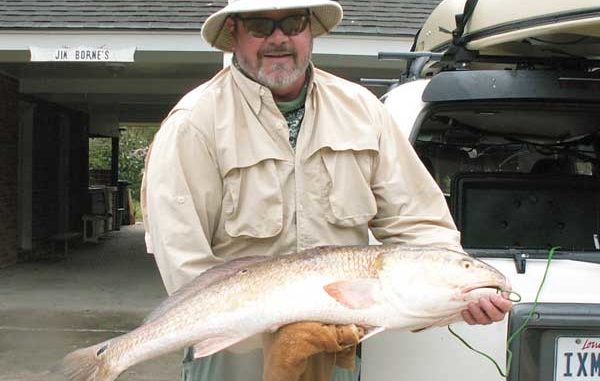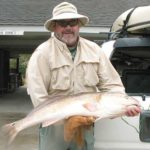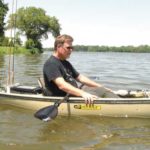
Two of Louisiana’s heavy hitters for springtime spawning bass are also loaded with publicly available ducks this time of year.
To appreciate the current trend in tackle requires a brief history lesson.Urban legend has it that the first fly rod was created in 10,000 B.C. when cavemen Frank Oog and JaMarcus Ugg cut and stripped a sapling and attached to it a line constructed of braided wooly mammoth hair.
A more credible beginning of our sport is documented by Claudius Aelianus in 200 A.D. The Roman scholar wrote that the Macedonians used red wool fastened around a hook, attached by line to a rod 6 feet in length.
In 1496, Dame Juliana Berners, considered ‘The Mother of Modern Fly Fishing,’ described the construction of rods in her day: “You must cut … a fair staff of a fathom and a half long of hazel, willow, or ash. And soak it in a hot oven, and set it straight.”
While a lot has changed with fly rods since the 15th century, one thing has remained constant. The 9-foot standard set by Dame Berners continues to be the most popular length.
Up until a decade ago, nearly all the rods manufactured were 9 feet or less. That was before spey casting exploded in popularity.
About 150 years ago in northern Scotland, flyfishers chasing Atlantic salmon on the Spey River faced a dilemma. They had to make very long casts to reach the fish. At the same time, there was no room for backcasting.
The spey cast was born of necessity. It involved rods as long as 24 feet, and use of the downstream current to load the rod for the forward cast (no backcast).
When Mike Maxwell and others introduced the spey cast to Americans in the 1990s, it fueled an infatuation with long rods. Within a few short years, every company was offering a wide range of spey and double-handed fly rods, ranging from 12 to 16 feet. Another variation, the single-handed distance rod, ranges from 10 to 12 feet in length.
Longer rods usually equate to longer casting. Anyone who fishes big waters, such as surf anglers, will find that these rods — with proper use — can give them the extra distance they crave.
How much distance? Steve Rajeff holds the world-record spey cast at 295 feet. His standard cast record is only 188 feet.
But longer isn’t necessarily better. There are many applications where casting distance isn’t important and a short rod has advantages. Examples include fishing from canoes or kayaks, or bass in heavy cover, or snook and tarpon under mangrove canopies.
Bottom line: 295 feet is about 250 feet farther than the vast majority of us ever catch fish.
When long rods first hit the market, the industry was prosperous. Manufacturers could offer several lengths to every model weight. For example, an 8-weight rod usually came in 8-foot, 8 1/2-foot, 9-foot and 10-foot lengths.
As the economy slowed, saltwater rods (7- to 12-weight) shorter than 9 feet took the hit. By 2006, if you wanted a 7-weight rod under 9-feet, you were just plum out of luck.
So why are short rods all the craze for 2009?
Realize that there are far greater numbers of fly anglers who fish short than fish long, and therefore, benefit from short rods. The demand was there, but no supply.
In 2007, Temple Fork fed the supply-side economics with its 7-1/2 foot, 8-weight TiCR model. Last year, Sage introduced the LMB (Largemouth Bass) and SMB (Smallmouth Bass) series of short rods. They became the best-selling rods of the year.
It didn’t take long for others to jump on the bandwagon. The recent Fly Tackle Retailers Show in Denver was a showcase for several new short-rod offerings for 2009.
Redington has introduced its Predator Series rods, ranging from a 7-foot, 10-inch 6-weight to a 8-foot, 3-inch 10-weight. All Predator rods come with anodized machined aluminum reel seats, PacBay titanium-chrome stripping guides, fighting butts, a Cordura rod tube and rod sock. They come with a limited lifetime manufacturer’s warranty. Price is $199.
Loomis Shorestalker rods range from an 8-foot 5-weight to an 8-foot, 6-inch 9-weight. Designed for highly accurate casting in the range of 20 to 60 feet, Loomis claims these rods are ideal for placement of large poppers, streamers and hair bugs, and have the muscle to pull fish away from structure. Prices range from $320 to $350.
Scott Warmwater series rods are legal for bass tournaments at just under 8 feet. They’re also ideally suited for saltwater anglers fishing docks and structure with a need to yank fish out. Models include a 6-weight, 8-weight and 10-weight. Price is $625, and includes rod tube and owner’s lifetime warranty.
Although not featured at any shows, the Bass Pro Gold Cup Extreme deserves checking out. This rod has been very popular in Florida, and is just starting to get some attention in Louisiana and Texas. I’ve found it a bit stiff, perhaps too fast an action for my moderate tastes, but a rocket when matched with a Mastery Redfish Taper line. Models range from a 7-foot, 10-inch 6-weight to a 8-foot, 3-inch 9-weight. Price is $159.
Northshore club back
The Ponchartrain Basin Fly Fishers lost a lot of members following Katrina, but according to Treasurer Cory Barbier, they’re currently rebuilding the club. If you live on the Northshore area, and enjoy talking or fishing with like-minded folks, check out their website at www.northshoreflyfishing.org. They meet the first Wednesday of each month at New Orleans Food and Spirits on Lee Lane in Covington at 7 p.m.
New kayak fishing club
The Lafayette Kayak Fishing Club was recently organized, and according to club president Greg Sonnier, they’ll meet on the third Tuesday of each month starting in January. Location will be Pack and Paddle on Pinhook. Some of their outings will be to Cypremont Point for reds and specks and Lake Martin for bass and bream.




